Top PDF Generation Libraries for Node.js in 2025
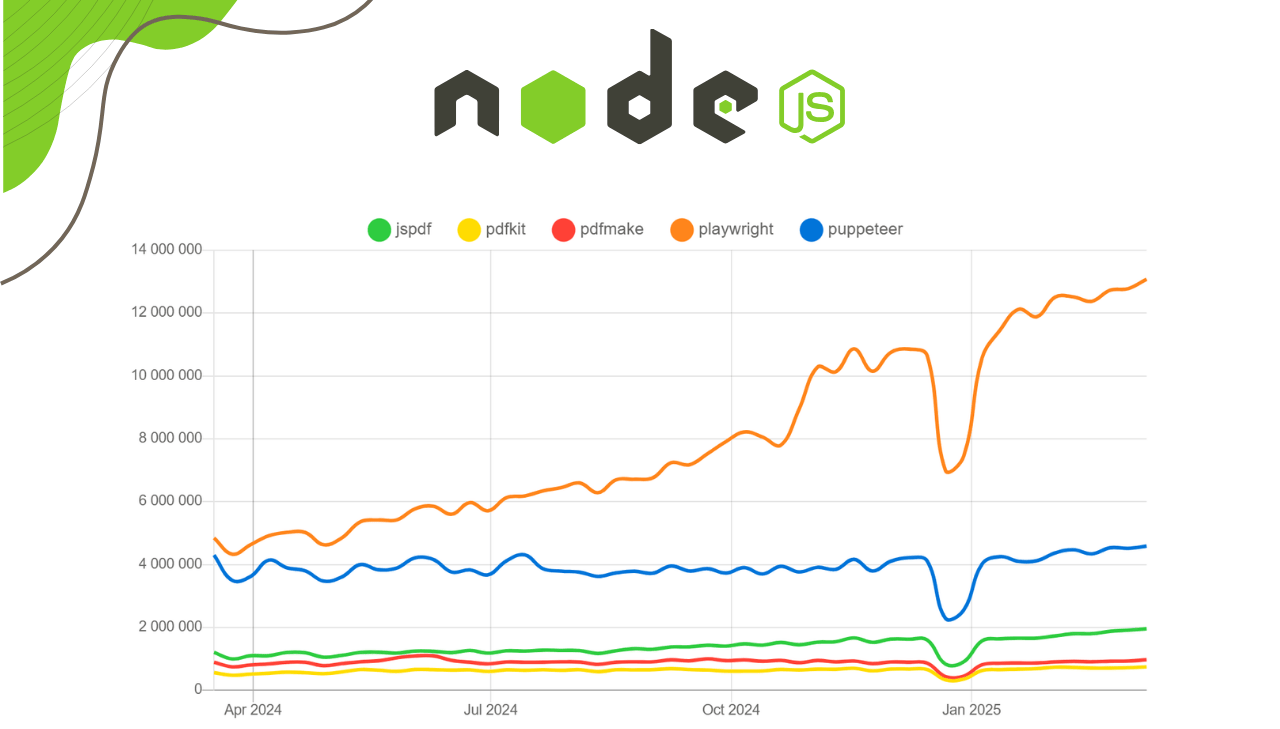
As we progress through 2025, the Node.js ecosystem continues to offer robust solutions for PDF generation. This article explores the most popular and powerful libraries available today, helping you make an informed decision for your next project. We provide detailed download statistics and simple code examples to give you insights into their real-world usage.
Download Statistics: Most Popular Node.js PDF Libraries
Let's first look at which libraries are most widely adopted by developers.
The following table presents download metrics from npm-stat:
| Library | Downloads Last Year | Downloads Last Month | Downloads Last Week |
|---|---|---|---|
| Playwright | 407,064,879 | 50,672,192 | 12,796,686 |
| Puppeteer | 203,644,693 | 17,816,566 | 4,499,859 |
| jsPDF | 71,380,100 | 7,439,702 | 1,914,861 |
| pdfmake | 45,947,891 | 3,694,281 | 931,838 |
| pdfkit | 32,466,202 | 2,855,594 | 714,075 |
Visual Representation of Download Trends
Below is a chart illustrating the monthly download trends for these libraries from March 2024 to March 2025. The data is sourced from npm-stat:
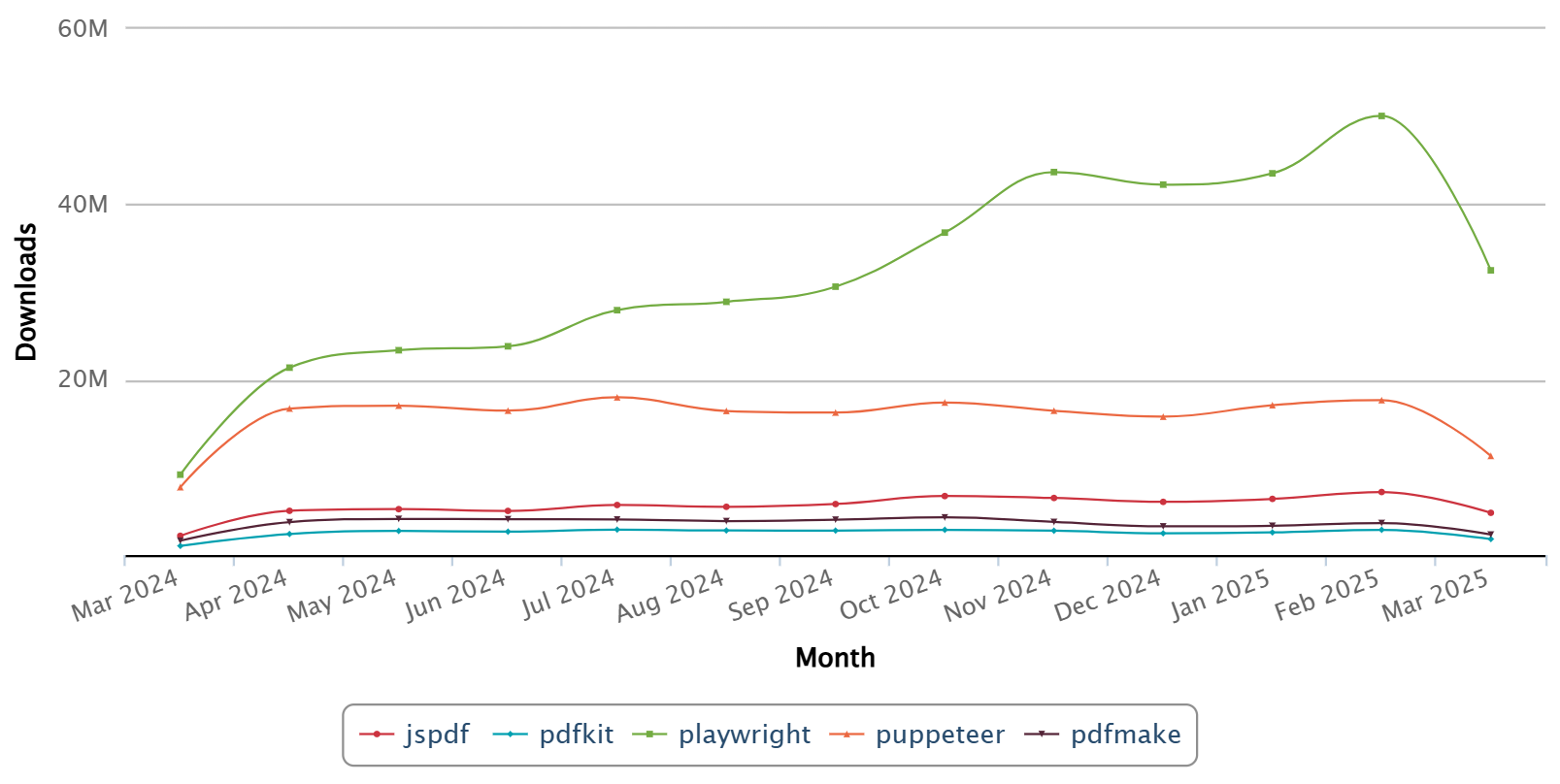
These numbers offer valuable insight into the community's trust and reliance on each solution, though your specific project requirements should ultimately determine which library is the best fit.
Comprehensive Review of Top PDF Libraries
Below, we’ll take a closer look at each library, examining its features and download trends. The following data is sourced from npm trends.
Playwright
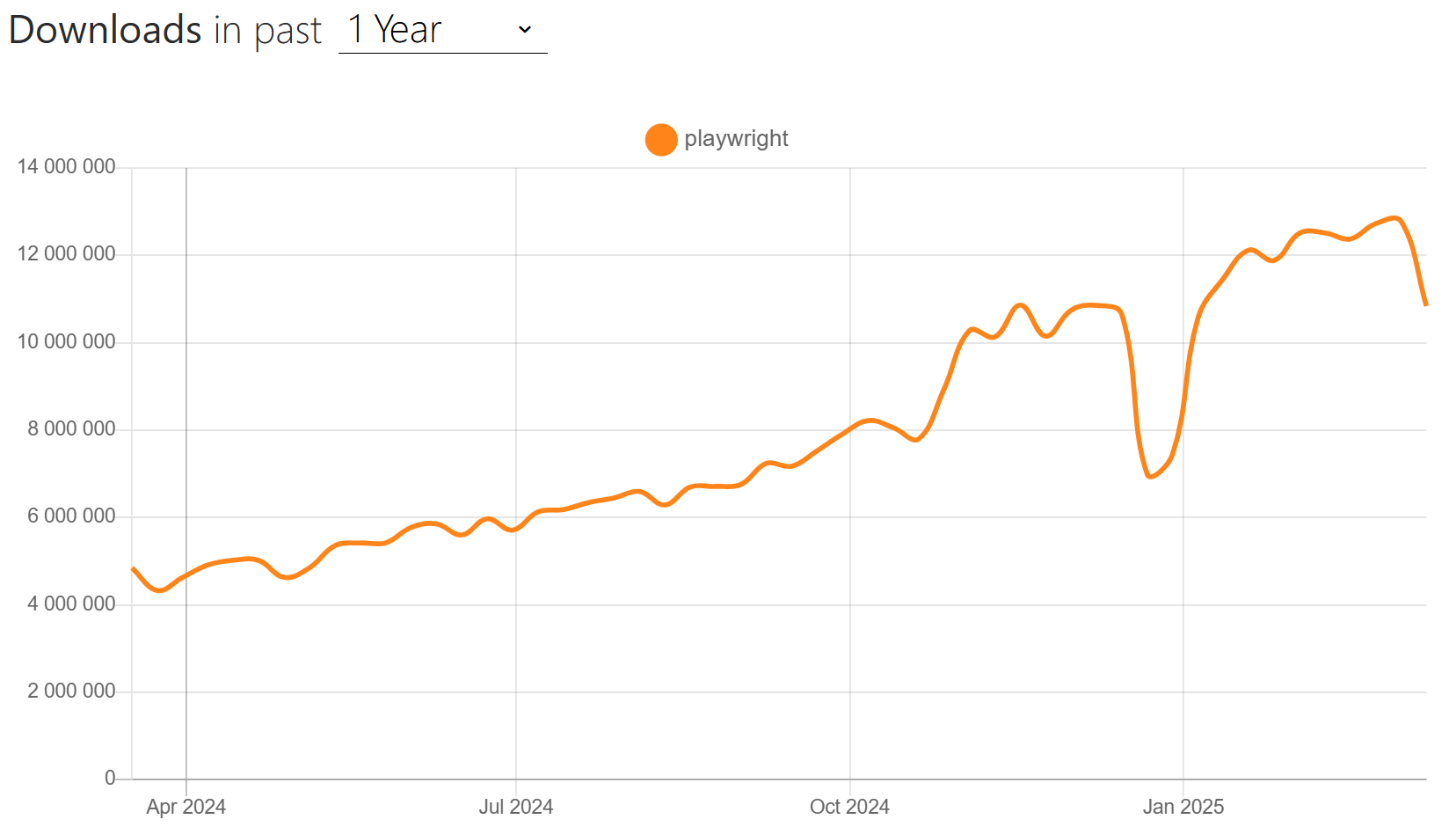
Playwright is a modern browser automation library developed by Microsoft. It supports multiple browsers, making it an excellent choice for generating PDFs from dynamic, JavaScript-heavy web pages.
➡️ Key Features:
- Multiple browser engines support (Chromium, Firefox, WebKit).
- Modern web technology compatibility.
- Robust CSS and JavaScript support.
- Effective waiting mechanisms for dynamic content.
- Advanced page formatting for high-quality PDF generation.
➡️ Setting Up Playwright:
npm install playwright
After installation, you'll need to run the following command to download new browsers:
npx playwright install
➡️ PDF Generation with Playwright:
- Code
- PDF Preview
const { chromium } = require('playwright');
async function generateDocument() {
// Launch a browser instance
const browser = await chromium.launch();
const context = await browser.newContext();
const page = await context.newPage();
// Define your HTML content
const htmlContent = `
<html>
<head>
<meta charset="utf-8">
<title>Playwright PDF Example</title>
<style>
body { font-family: Helvetica, sans-serif; text-align: center; }
h1 { color: #267129; }
</style>
</head>
<body>
<h1>PDF Generated with Playwright</h1>
<h2>Why did the bicycle fall over?</h2>
<h3><strong>Because it was two tired!</strong></h3>
</body>
</html>
`;
// Set the page content
await page.setContent(htmlContent);
// Generate PDF
await page.pdf({
path: 'playwright-document.pdf',
format: 'A5',
printBackground: true,
margin: {
top: '50px',
right: '30px',
bottom: '30px',
left: '30px'
}
});
// Close browser
await browser.close();
}
generateDocument()
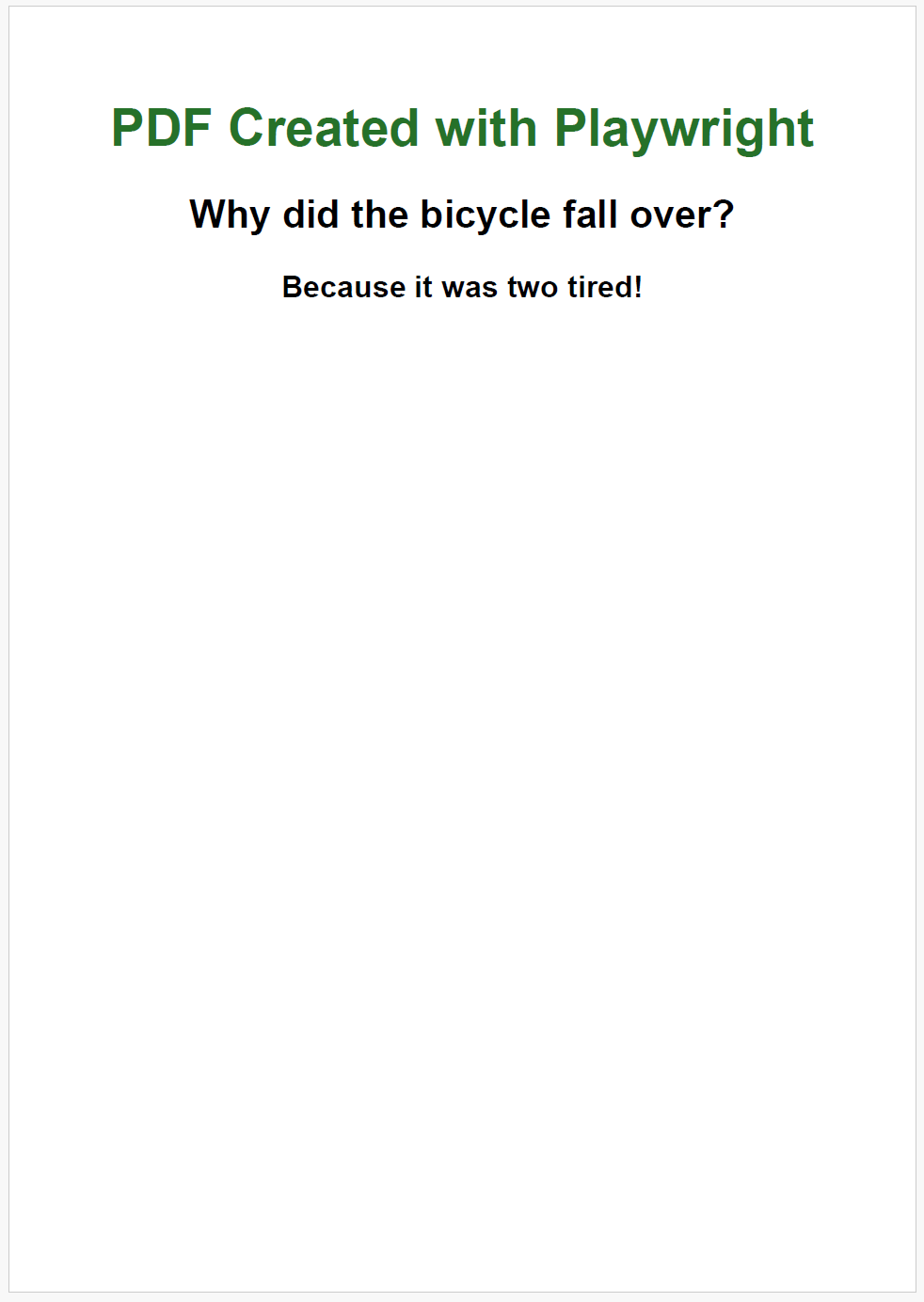
For a detailed, step-by-step guide on generating an invoice PDF using Playwright, please refer to our previous article How to Generate PDFs in 2025.
Puppeteer
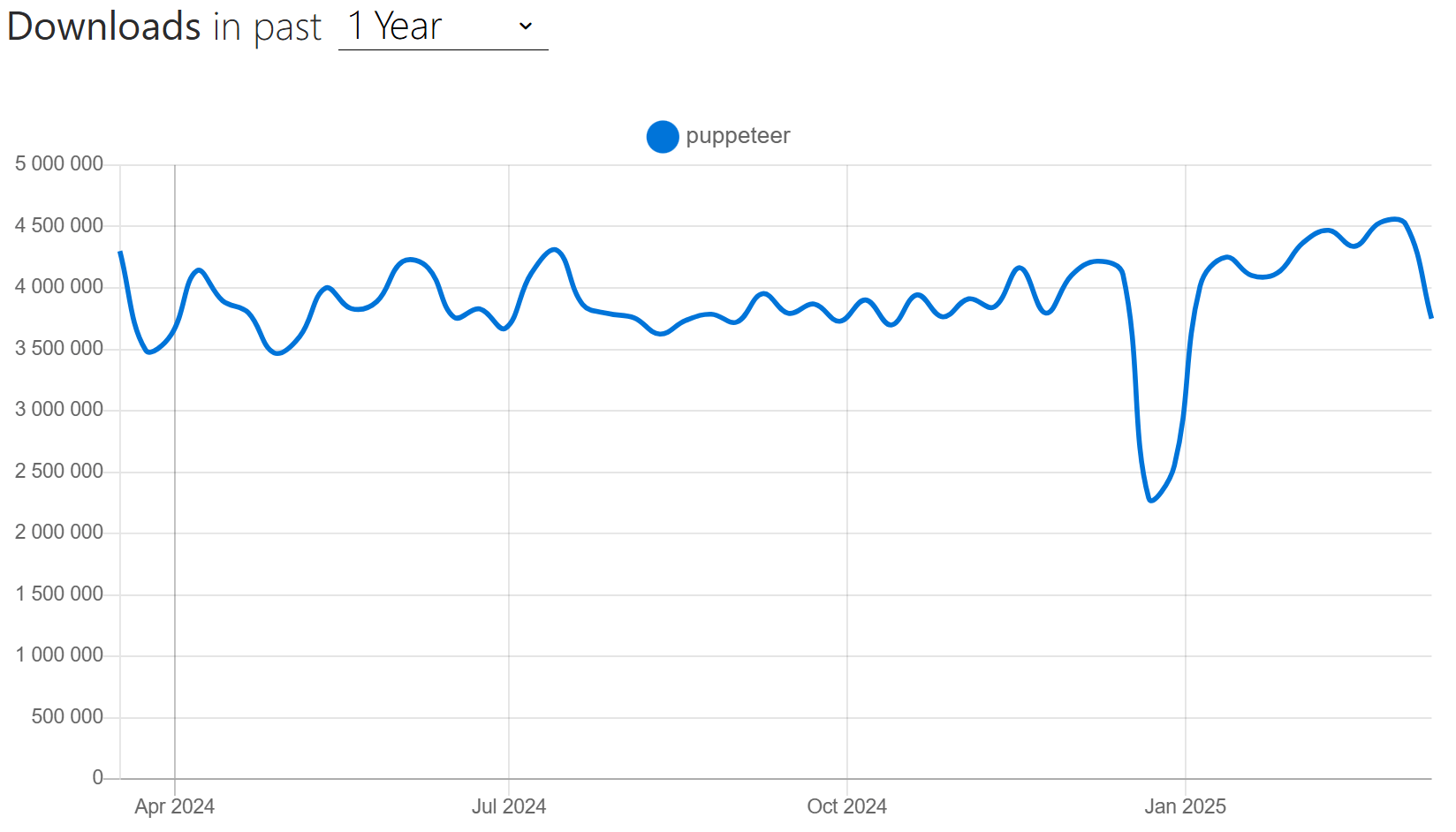
Puppeteer is a Node.js library developed by Google that provides a comprehensive API for controlling headless Chrome or Chromium browsers, making it exceptionally powerful for converting HTML to PDF. Puppeteer ensures high-quality output that accurately reproduces modern web layouts.
➡️ Key Features:
- Chrome/Chromium-based rendering for excellent HTML/CSS compatibility.
- Support for modern CSS, JavaScript, and web APIs.
- Customizable page settings (margins, format, orientation).
- Header and footer templates.
- Ability to generate PDFs from single-page applications (SPAs).
➡️ Installation:
npm install puppeteer
This installs both the API and a compatible version of Chromium.
➡️ HTML to PDF Conversion Example:
- Code
- PDF Preview
const puppeteer = require('puppeteer');
async function createPDF() {
// Launch a headless browser instance
const browser = await puppeteer.launch();
const page = await browser.newPage();
// Define your HTML content
const htmlContent = `
<html>
<head>
<meta charset="utf-8">
<title>PDF Document Example</title>
<style>
body { font-family: Arial, sans-serif; }
h1 { color: #0C76C39B; }
</style>
</head>
<body>
<h1>PDF Generated with Puppeteer</h1>
<h2>What's a computer's favorite snack?</h2>
<h3>Microchips, of course!</h3>
</body>
</html>
`;
// Load the HTML into the page
await page.setContent(htmlContent);
// Generate and save the PDF
await page.pdf({
path: 'puppeteer-document.pdf',
format: 'A5',
printBackground: true,
margin: {
top: '30px',
right: '30px',
bottom: '30px',
left: '30px'
}
});
// Close browser
await browser.close();
}
createPDF()
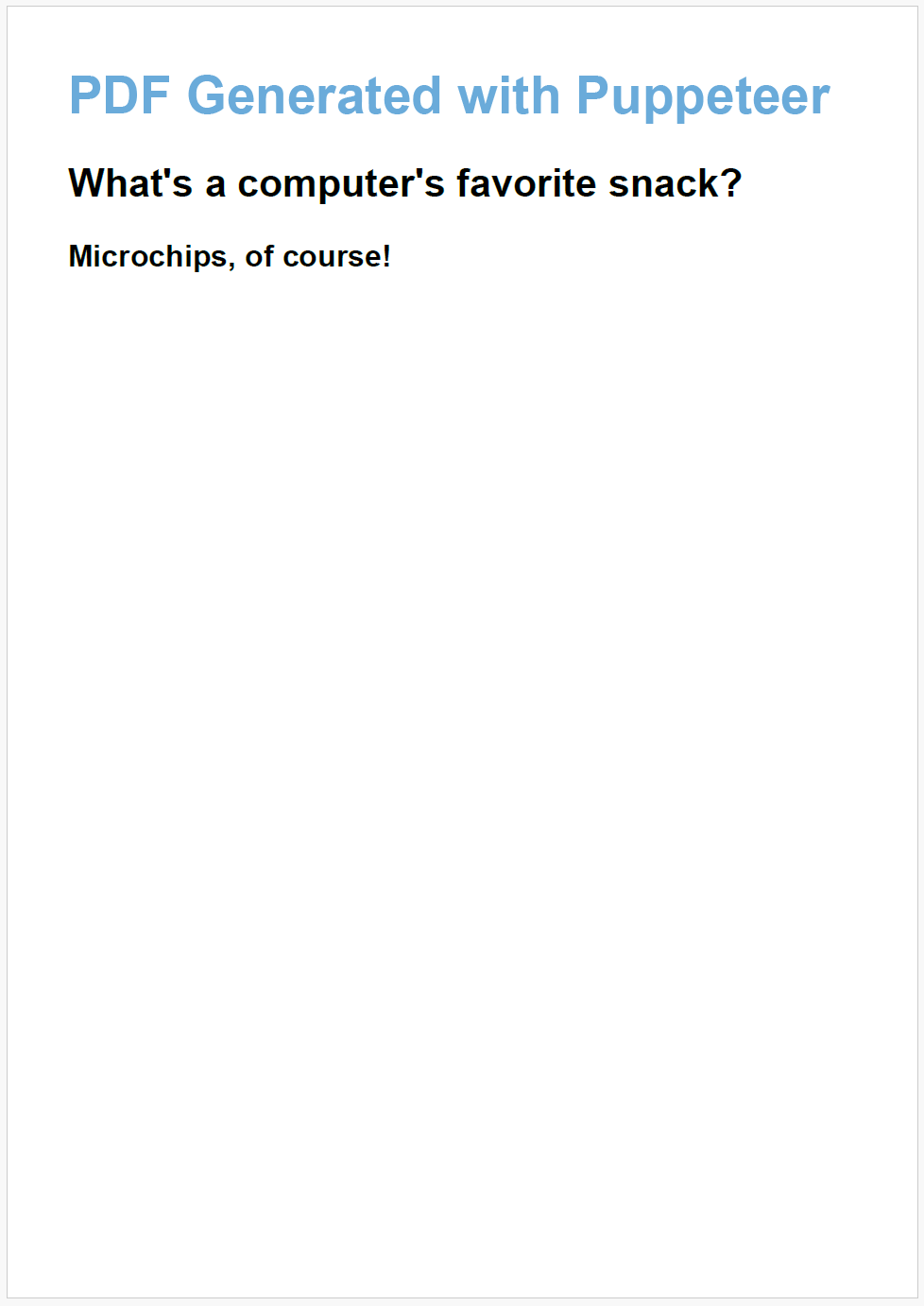
Want to master Puppeteer for PDF generation? Check our in-depth guide: Generate PDFs in Node.js Using Puppeteer.
jsPDF
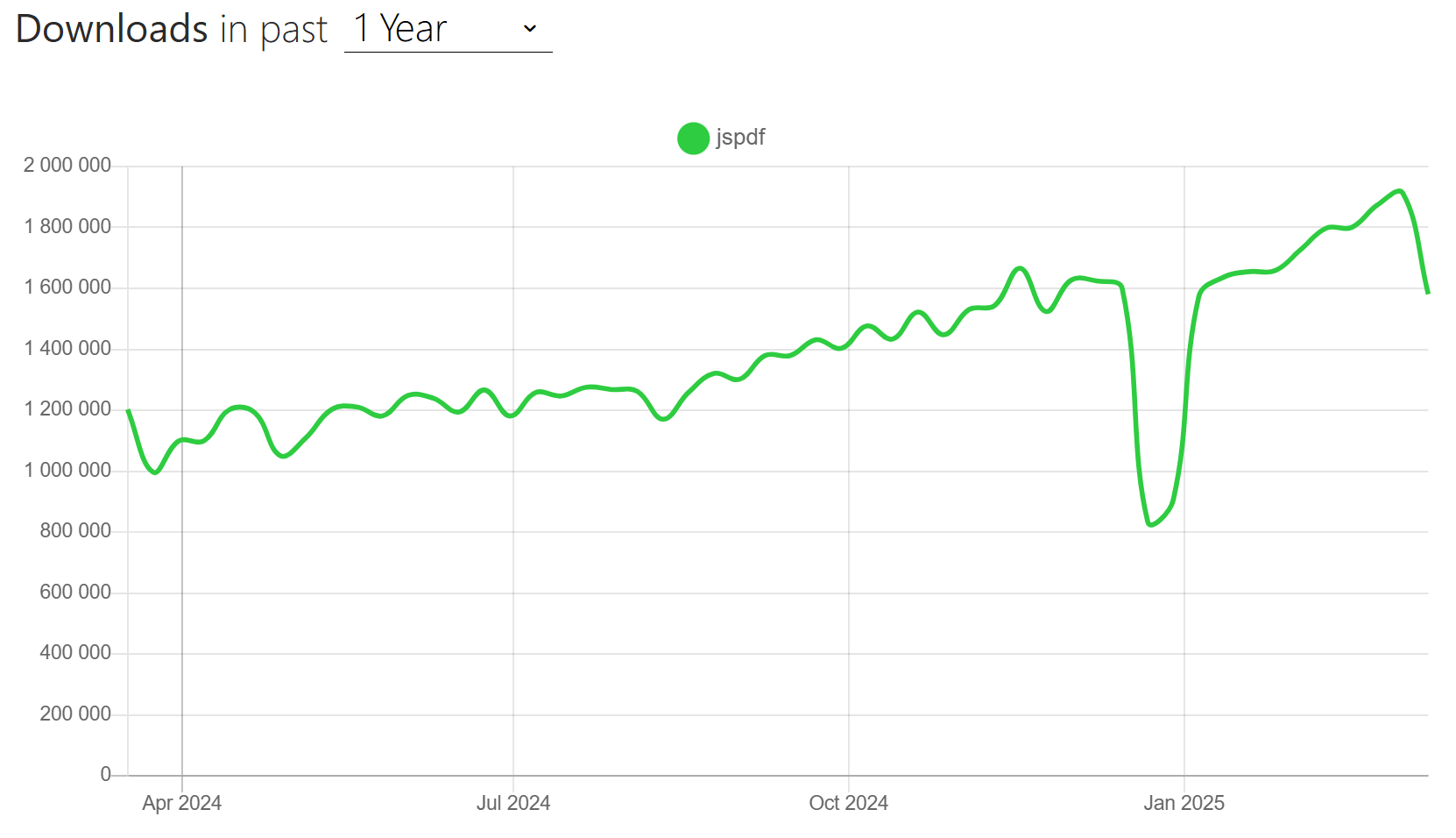
jsPDF was originally developed for client-side PDF generation in browsers but has become equally popular for server-side document creation in Node.js. Its versatility across environments and straightforward API make it an excellent choice for projects that may need to generate documents in both frontend and backend contexts.
➡️ Key Features:
- Works in both browser and Node.js environments.
- Lightweight and focused on the essentials.
- Text, images, and vector graphics support.
- Plugin architecture for extensibility.
- Support for tables, charts, and other common elements.
➡️ Installation:
npm install jspdf
➡️ Basic Document Generation
- Code
- PDF Preview
const { jsPDF } = require('jspdf');
function createPDF() {
// Create a new document
const doc = new jsPDF({
orientation: 'portrait',
unit: 'mm',
format: 'a5'
});
// Add a title
doc.setFont('helvetica', 'bold');
doc.setFontSize(24);
doc.setTextColor(13, 71, 161);
doc.text('PDF Generated with jsPDF', 74, 30, { align: 'center' });
// Add some text
doc.setFont('helvetica', 'normal');
doc.setFontSize(16);
doc.setTextColor(33, 33, 33);
doc.text('Why don\'t scientists trust atoms?', 74, 60, { align: 'center' });
doc.setFont('helvetica', 'bold');
doc.setFontSize(18);
doc.setTextColor(33, 33, 33);
doc.text('Because they make up everything!', 74, 80, { align: 'center' });
// Save the PDF
doc.save('jspdf-document.pdf');
}
createPDF()
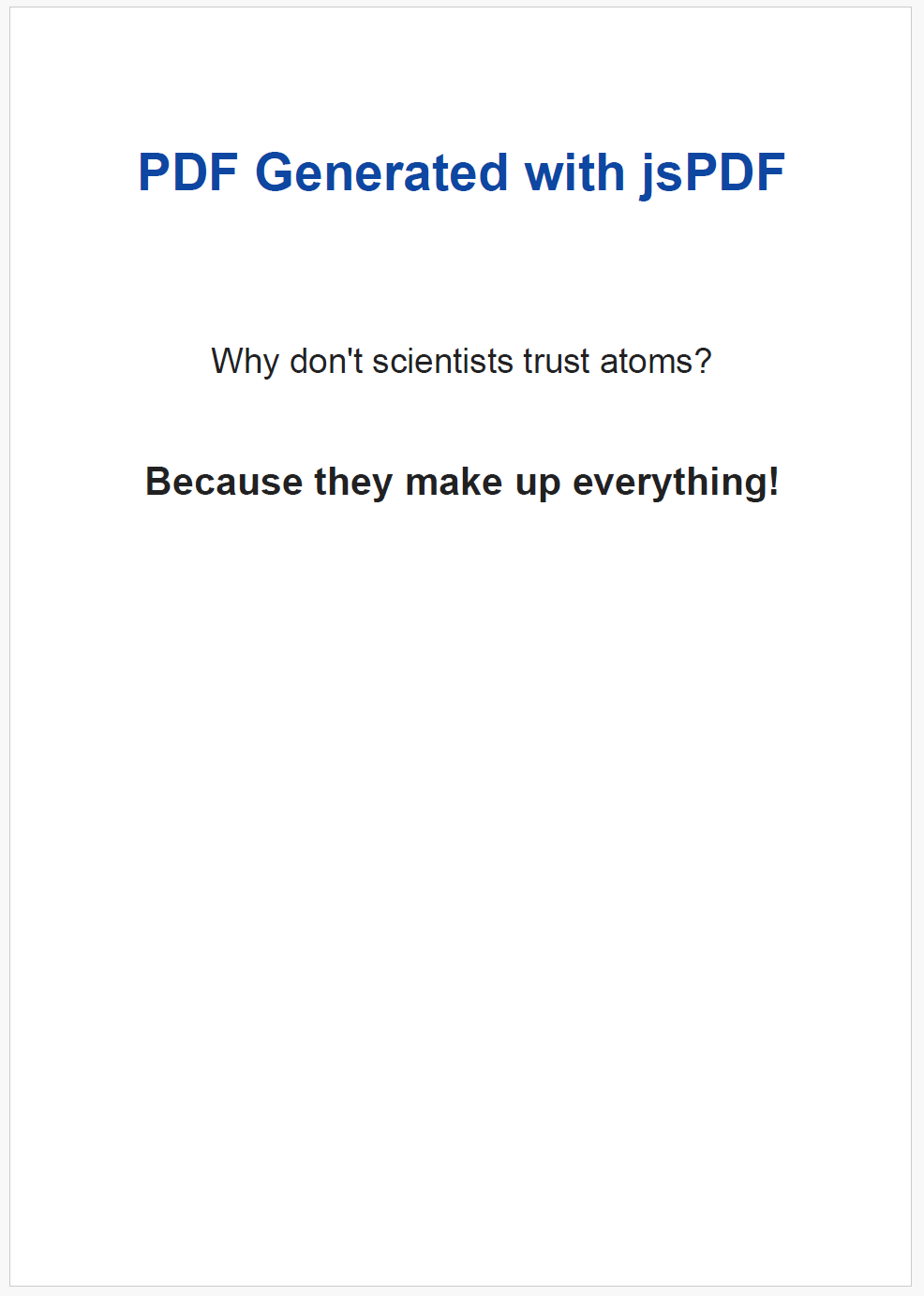
If you need a guide on how to generate client-side PDFs, please check out our article: Generate PDFs with jsPDF: A Complete Guide to Client-Side PDF Creation.
PDFMake
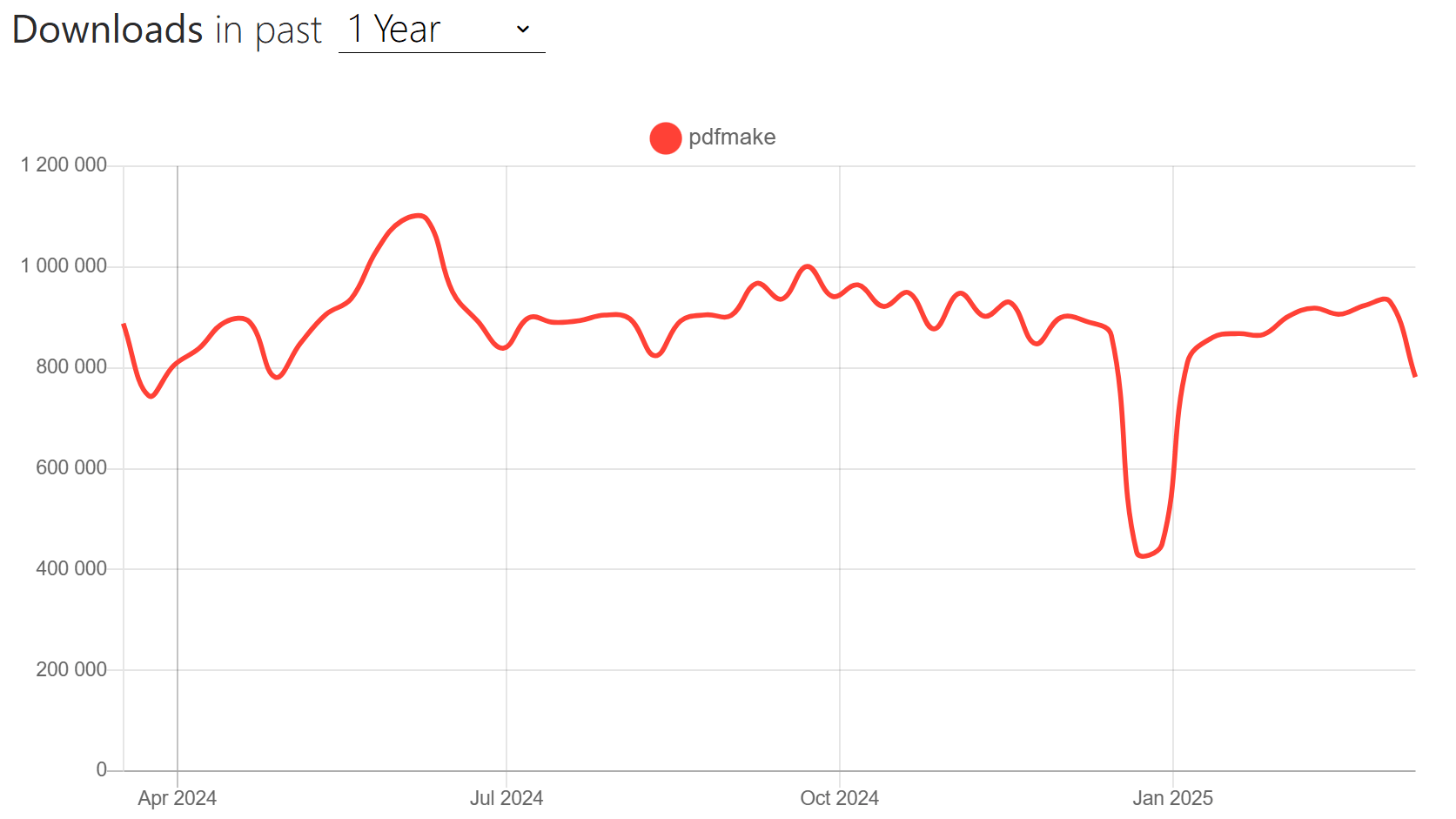
PDFMake is a flexible library for generating PDFs using a declarative, JSON-based approach. It enables developers to design complex, well-styled documents with minimal code, making it ideal for both client and server-side applications.
Key Features:
- Declarative document definition syntax.
- Advanced layout with tables, lists, and columns.
- Built-in styling system.
- Automatic page breaking and headers/footers.
- Support for client and server-side usage.
➡️ Installation:
npm install pdfmake
➡️ Declarative Document Creation
- Code
- PDF Preview
const PdfPrinter = require('pdfmake');
const fs = require('fs');
// Define font files (ensure the paths are correct and the font files exist in your project)
const fonts = {
Roboto: {
normal: 'fonts/Roboto-Regular.ttf',
bold: 'fonts/Roboto-Medium.ttf',
italics: 'fonts/Roboto-Italic.ttf',
}
};
const printer = new PdfPrinter(fonts);
// Define document structure
const documentDefinition = {
pageSize: 'A5',
pageOrientation: 'portrait',
content: [
{
text: 'PDF Generated with PDFMake',
style: 'header',
color: '#dd7ee8',
alignment: 'center'
},
{
text: 'Why don\'t eggs tell jokes?',
style: 'question',
alignment: 'center'
},
{
text: 'They\'d crack each other up!',
style: 'answer',
alignment: 'center'
}
],
styles: {
header: {
fontSize: 22,
bold: true,
margin: [0, 20, 0, 10]
},
question: {
fontSize: 16,
margin: [0, 20, 0, 10]
},
answer: {
fontSize: 18,
bold: true,
margin: [0, 10, 0, 0]
}
}
};
// Create the PDF
const pdfDoc = printer.createPdfKitDocument(documentDefinition);
pdfDoc.pipe(fs.createWriteStream('pdfmake-document2.pdf'));
pdfDoc.end();
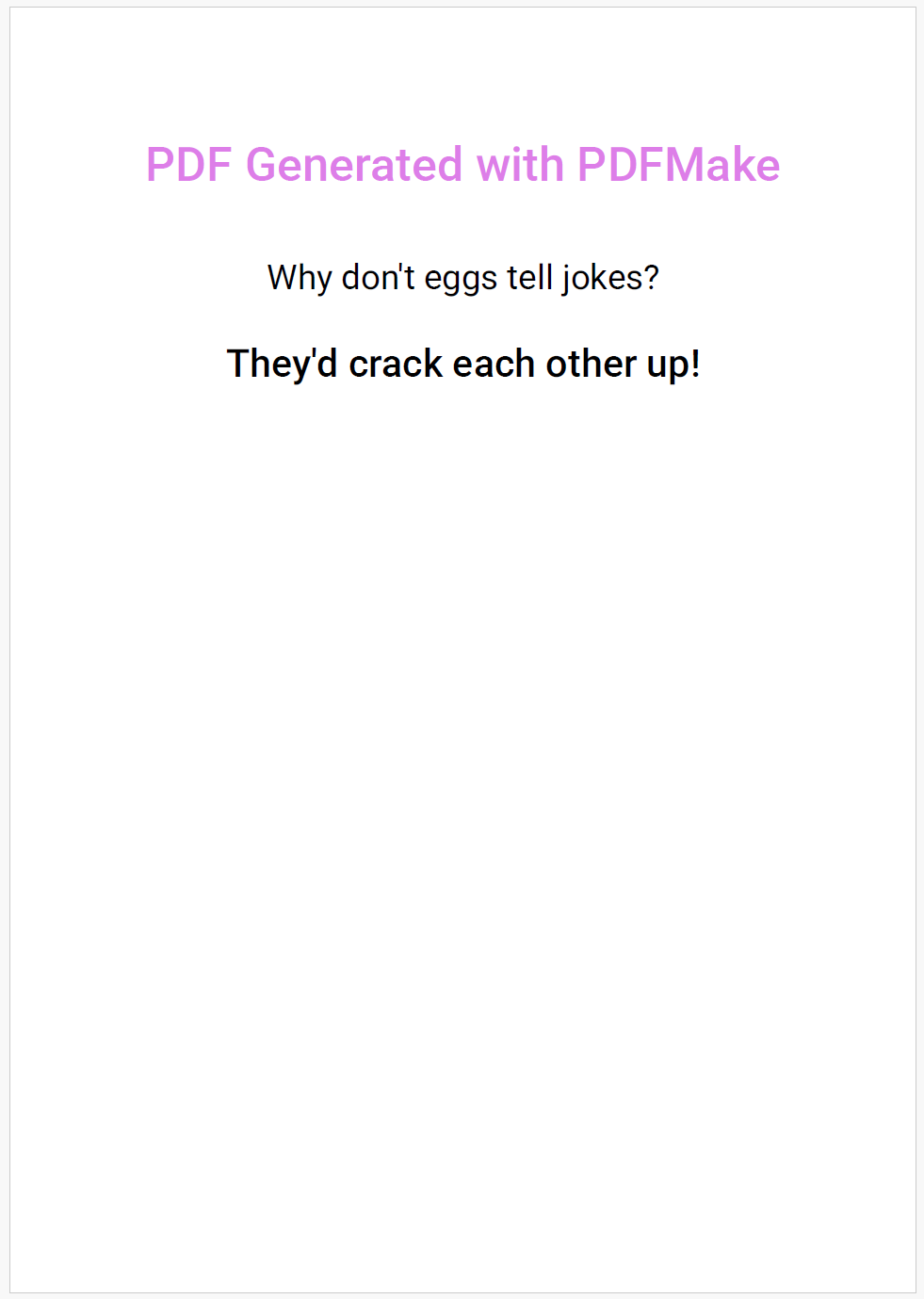
Explore our comprehensive tutorial – Generate PDF Using PDFMake in Node.js.
PDFKit
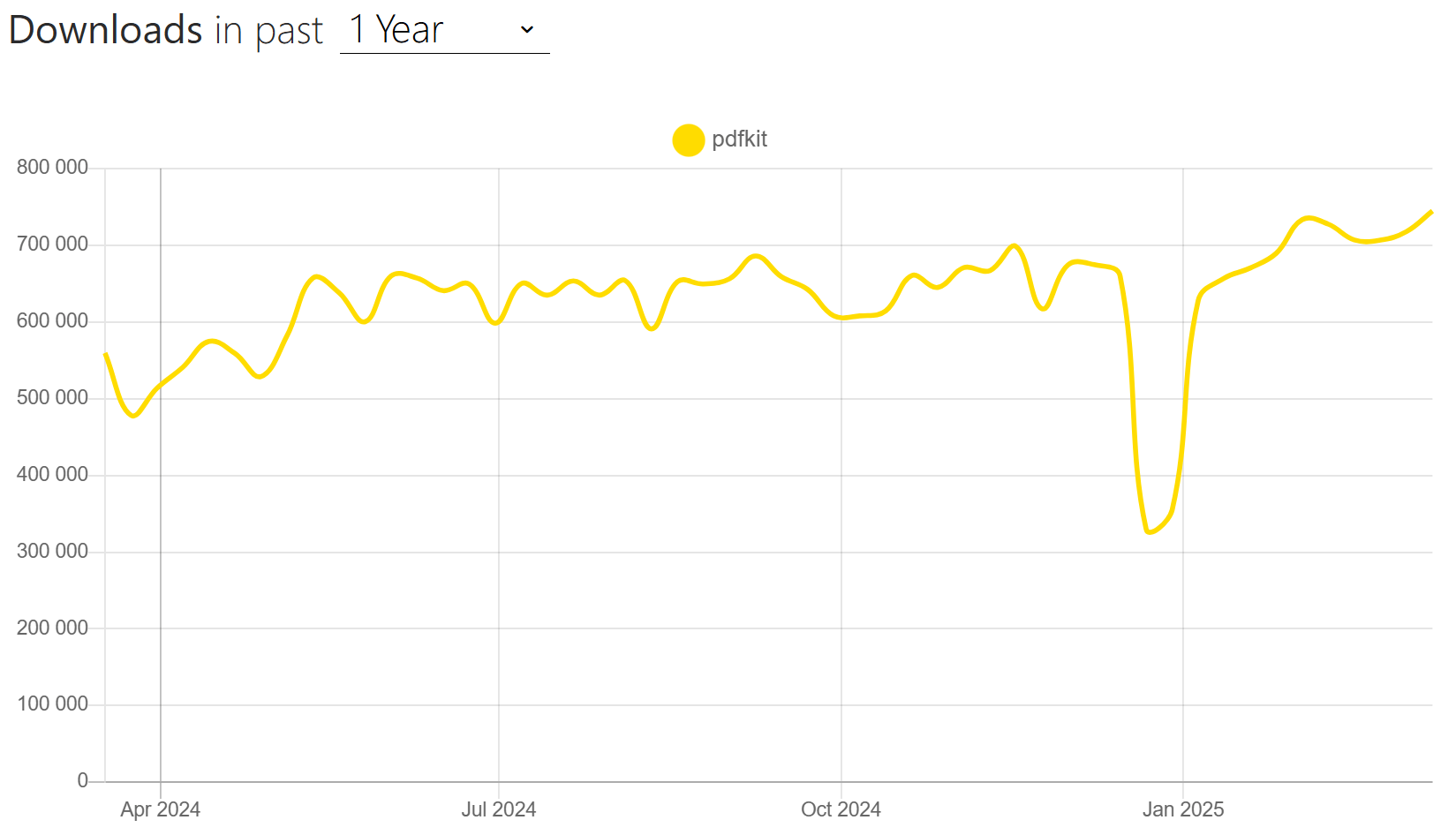
PDFKit uses a canvas-like API to create PDFs from scratch rather than converting HTML. This approach gives developers precise control over every element, making it ideal for applications that require exact positioning, vector graphics, and consistent text formatting.
➡️ Key Features:
- Document creation from scratch with precise control.
- Text, vector graphics, and image support.
- Advanced typography and text layout.
- Streaming API** for optimized memory usage.
- Annotation and form support.
➡️ Installation:
npm install pdfkit
➡️ Document Creation Example
- Code
- PDF Preview
const PDFDocument = require('pdfkit');
const fs = require('fs');
function createPDF() {
// Initialize a new document
const doc = new PDFDocument({
size: 'A5',
margin: 40
});
// Set up file output
doc.pipe(fs.createWriteStream('pdfkit-document.pdf'));
// Add title
doc.font('Helvetica-Bold')
.fontSize(24)
.fillColor('#951111')
.text('PDF Generated with PDFKit', {
align: 'center'
})
.moveDown(1);
// Add some text
doc.font('Helvetica')
.fontSize(16)
.fillColor('black')
.text('What did the ocean say to the beach?', {
align: 'center'
})
.moveDown(1);
doc.font('Helvetica-Bold')
.fontSize(18)
.fillColor('black')
.text('Nothing, it just waved!', {
align: 'center'
});
// Finalize the document
doc.end();
}
createPDF()
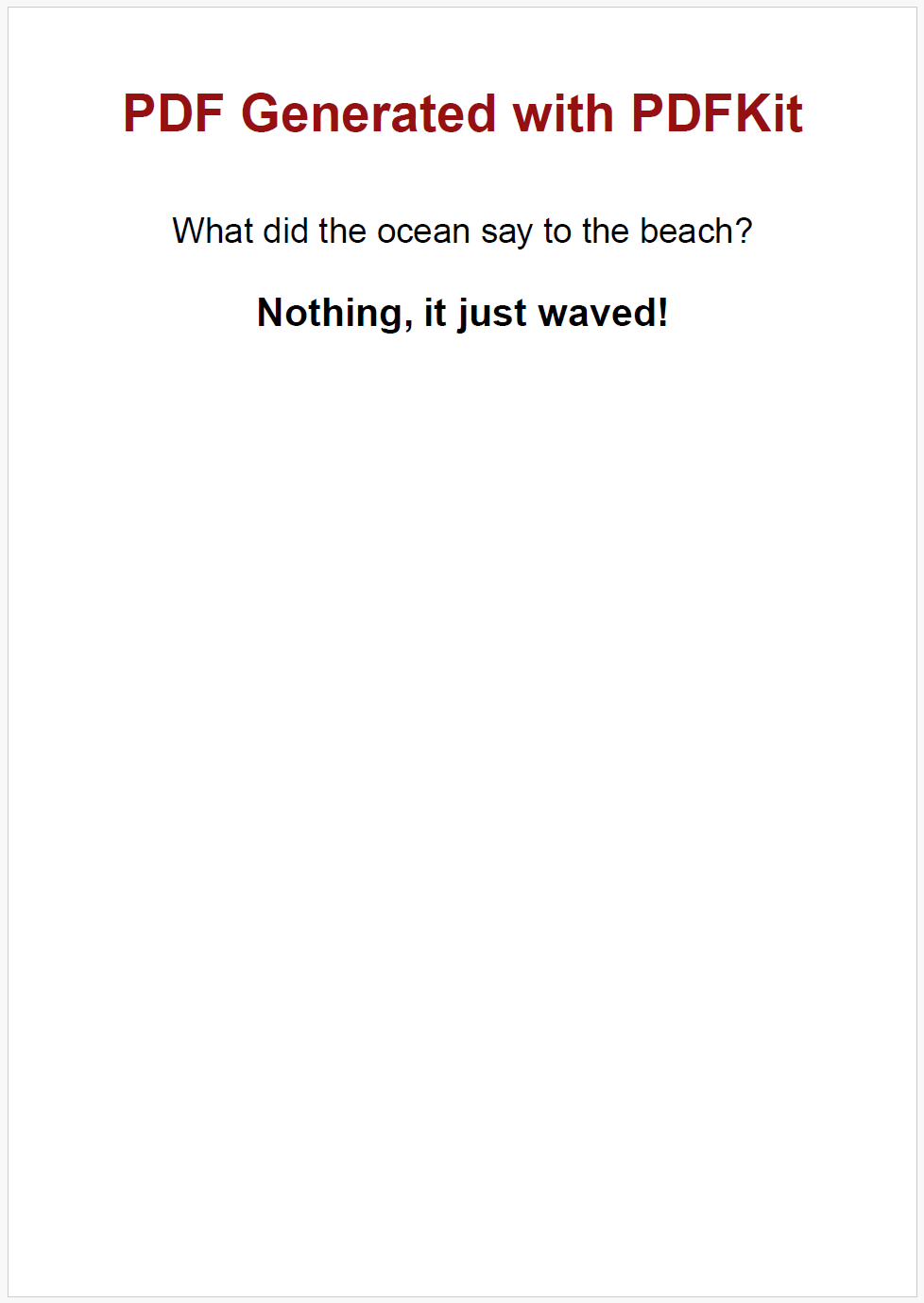
For more advanced examples and techniques, read our article: How to Generate PDF in Node.js Using PDFKit.
Alternative: Cloud-Based PDF Generation Services
For developers looking for alternatives to self-hosted solutions, many cloud-based HTML to PDF APIs provide simplified integration without the complexities of managing libraries and dependencies. These services typically offer:
- Easy REST API implementation.
- Server environments that don’t require a browser.
- Scalable infrastructure for high-volume document generation.
- Consistent rendering across platforms.
- Advanced features like headers/footers and page formatting.
When evaluating third-party services, consider factors such as pricing, performance, security, and the specific features your application requires.
Selecting the Optimal Library for Your Project
When choosing a PDF generation library, keep these key factors in mind:
- Content complexity: Browser-based solutions like Puppeteer and Playwright excel at handling dynamic, JavaScript-heavy content.
- Browser compatibility: If cross-browser consistency is important, Playwright’s multi-engine support offers distinct advantages.
- Document structure: For heavily structured documents like invoices or reports, PDFMake’s declarative approach simplifies development.
- Customization needs: For pixel-perfect control, canvas-based libraries such as PDFKit provide great precision.
- Environment requirements: Consider whether your solution needs to work in both Node.js and browser contexts.
- Document volume: For high-throughput applications, evaluate performance characteristics or consider cloud services.
Conclusion
The Node.js ecosystem offers a wide range of tools for PDF generation, each tailored to specific use cases and requirements. For dynamic web content, browser-based solutions like Puppeteer and Playwright deliver superior results. When it comes to structured business documents, PDFMake’s declarative syntax streamlines development, while canvas-based libraries like PDFKit provide the fine-grained control needed for precision layouts. Additionally, jsPDF offers versatility by bridging client-side and server-side PDF generation, making it an excellent choice for projects that demand flexibility across environments.
By understanding the strengths, limitations, and implementation approaches of each library, you can confidently choose the optimal solution for your needs – ensuring efficient and effective PDF generation in your applications.
May your documents always render flawlessly! 🚀
